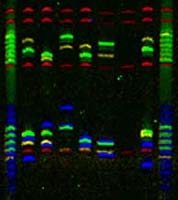Standard improves tests of male DNA

Columns of a DNA gel show the sizes of Y chromosome fragments from 6 male and 1 female sample (empty lane third from right).
Mother Goose tells us that boys are made of “snips and snails and puppy dog tails.” She was clearly misinformed about the snails and tails, but she was on to something with the snips. What you really need to build a boy is a “Y” chromosome, and it turns out that SNPs (single nucleotide polymorphisms), known by the biotech cognoscente as simply “snips,” can be helpful in sorting out who fathered the boy. If DNA can be thought of as an instruction book for building a specific person, then SNPs are single letters at an exact location in that book that tend to vary among individuals.
A new Standard Reference Material (SRM) issued by the National Institute of Standards and Technology (NIST) uses both SNPs and STRs (sections where three to five DNA “letters” form repeating patterns) to help improve the reliability of laboratory analyses of male DNA. The result of several years of research, the standard consists of six vials of very carefully analyzed DNA. Five are male samples, and one is female. Laboratories that perform forensics or paternity DNA analyses can use the SRM to double check the accuracy of their equipment and test procedures for analyzing the Y chromosome. It also may be helpful for population studies that study whether the human race evolved from one or many “Adams.”
Each vial comes with certified DNA sequences for 22 different STR locations and 42 different SNPs. NIST research chemist Margaret Kline provided a detailed description of the SRM and the methods used in preparing it at the 14th International Symposium on Human Identification in Phoenix, Ariz., on Oct. 1, 2003.
Media Contact
More Information:
http://www.nist.gov/All latest news from the category: Life Sciences and Chemistry
Articles and reports from the Life Sciences and chemistry area deal with applied and basic research into modern biology, chemistry and human medicine.
Valuable information can be found on a range of life sciences fields including bacteriology, biochemistry, bionics, bioinformatics, biophysics, biotechnology, genetics, geobotany, human biology, marine biology, microbiology, molecular biology, cellular biology, zoology, bioinorganic chemistry, microchemistry and environmental chemistry.
Newest articles

Red light therapy for repairing spinal cord injury passes milestone
Patients with spinal cord injury (SCI) could benefit from a future treatment to repair nerve connections using red and near-infrared light. The method, invented by scientists at the University of…

Insect research is revolutionized by technology
New technologies can revolutionise insect research and environmental monitoring. By using DNA, images, sounds and flight patterns analysed by AI, it’s possible to gain new insights into the world of…

X-ray satellite XMM-newton sees ‘space clover’ in a new light
Astronomers have discovered enormous circular radio features of unknown origin around some galaxies. Now, new observations of one dubbed the Cloverleaf suggest it was created by clashing groups of galaxies….





















